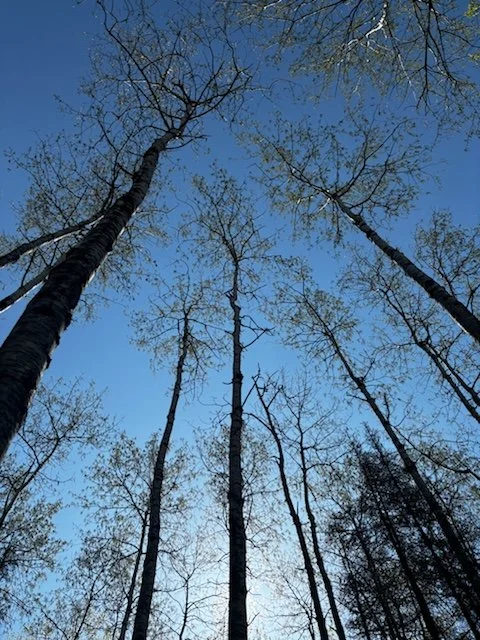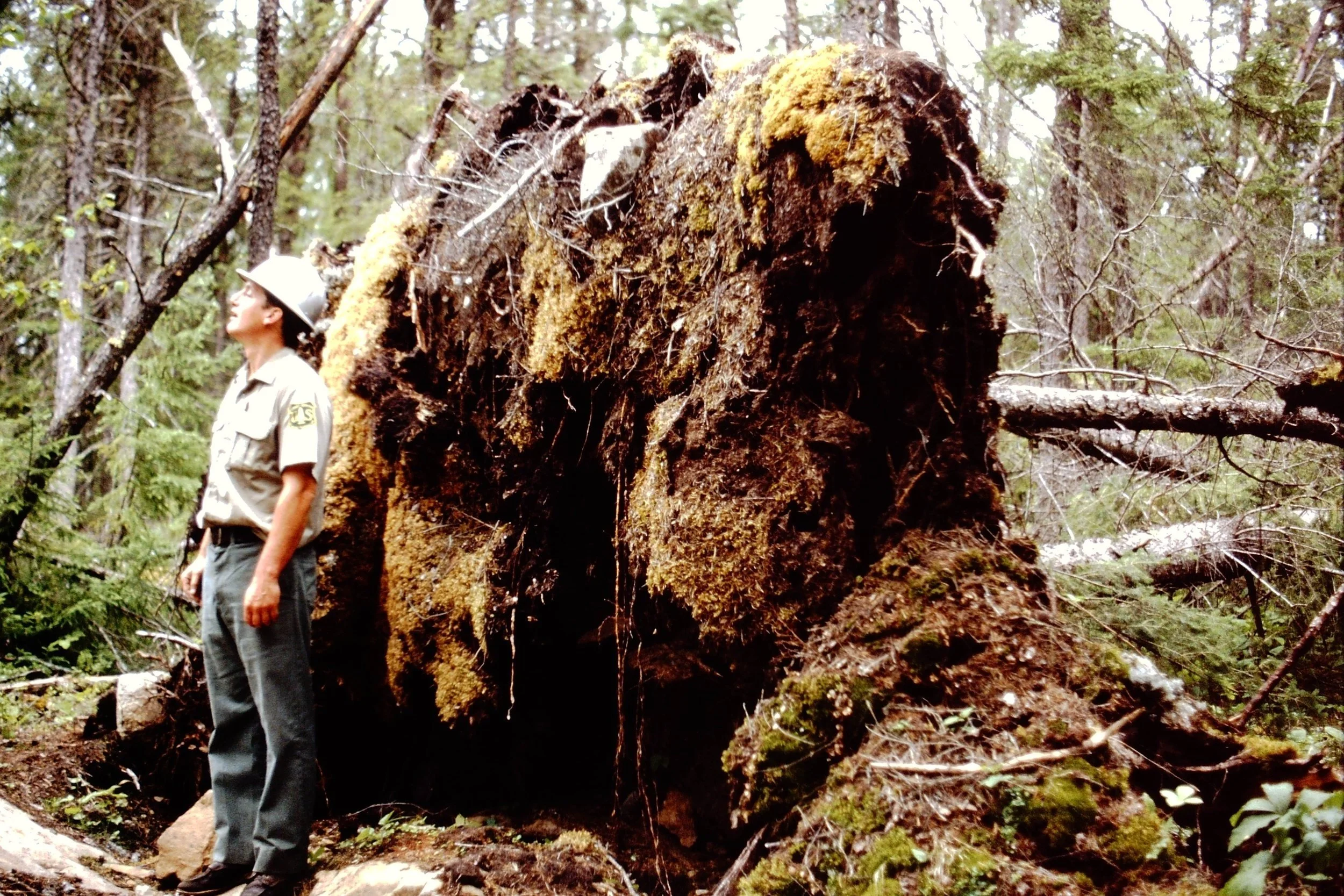Quaking Aspen: Questions and Lessons
In 1978 a tornado knocked over a mature stand of white pine on a hilltop in northeastern Minnesota. The fallen giants were salvage-logged, leaving only two-foot-wide stumps behind. In the sunlight of the cleared hilltop, quaking aspen seed fell and flourished. When we bought that hilltop in 1983, the saplings were already eight feet tall and grew in profusion, like prairie grass.
Six hundred feet isn’t far when you’re in your twenties, strolling down a firm, gently curving driveway, but it seems miles when you’re swimming your way through closely clustered light green, powdery boles with chartreuse leaves shimmering and shaking on myriad branches.
We dove into the brush to mark our future driveway. My woodsman had shown me how to walk single file through brush. I kept several paces between us. When he pushed through the dense growth, branches could whip back into place without striking my face and arms and shins. Mike had an amazing sense of direction. He read the slope of the ground with his feet when we could see only a foot or two in front of us. At intervals, he bowed a sapling over and tied a strip of blaze orange tape onto its upper branches, then one more at eye level.
I peered at large, rotting stumps and mourned the pine I never knew. But when the bulldozer driver followed our flagging, he mowed a swath through the aspen, killing thousands with each pass. I felt only a twinge watching so many little trees die. Space for our driveway and building site took precedent.
We thought of popple, the local term for aspen, as trash trees. We had so many! We burned wood for heat and sometimes resorted to burning stinky old popple. When a mature tree tumbled over there was a lot of wood. But it’s a soft wood—birch and maple produce better heat and hold it longer. We used the odd chunk of aspen as we started a fire, or burned it in the shoulder seasons when just a few degrees of warmth took the chill off morning or evening.
Maple trees made better firewood, but more important to us was their sap. We collected maple sap for syrup every spring. So, any aspen competing with maples were condemned. Mike mowed a large lawn atop our septic tank and field, and along the sides of the driveway. He wielded the brush saw with vigor around the garden and down the trails. He worked to keep those little suckers from springing into our septic field, driveway, and defensible space around the house. He strove to keep their roots from invading the septic tank and clogging up the drain field. He fought the d*** popple from shooting up and taking over the sky.
We killed so many! But the remaining aspen were persistent--offering their lessons and their gifts with quiet tenacity.
The quaking aspen soon outgrew the little red maples but shared thin soil, water, and sunlight with them. Red maples spilled maroon and orange leaves from where they flourished on the edge of the aspen nation. For many seasons, I treasured those colors while I barely noticed the wealth of gold coins the aspen trees tossed into the wind and onto the ground afterward.
And yet, I did have moments when I noticed and appreciated the popple. Our first baby, Joseph, was born in December during a brutal cold spell. We heated our home with wood and hauled water in five-gallon jugs, so the arrival of spring was a relief. One soft day in May, I stepped outside with our five-month-old baby in a front carrier. I looked down into his face and was babbling some Mommy thing when his focus changed to the sky above us. His look of wonder made me look up, too. Above us the aspen branches, barren his whole short life, had sprouted leaves. The sky was suddenly filled with millions of dime-sized tambourines in brilliant yellow green. A slight breeze set them quivering with light. With him in my arms, we strolled slowly below those newly burst leaves, wonderstruck and giggling. Even now, almost forty years later, I watch for the aspen leaves to pop, through the memory of an infant’s wonder.
Finally, Mike cleared the ground beneath the verdant popple and began calling it a shaded fuel break—isn’t that a lovely phrase? Well, maybe not to you, if you haven’t lived with balsam fir as ladder fuels, clearings as defensible space, and blow downs as fuel loads. But step into an aspen grove on a hot, dry summer day. Notice the greening of the light as it wavers through the trembling leaves. Take a seat on an old pine stump, breathe in the oxygen shed from these generous trees, and eavesdrop on the conversation between breezes and the leaves. Notice this cool, moist sanctuary—a shaded fuel break.
We fought the aspen until they won us over with quiet grace. At last, I’m awakening to the beauty of that truce in which the trees seceded the space of our living to us, while we grew to love them.
The old adage is familiarity breeds contempt, and I’ve seen that happen. But in my experience, familiarity is as likely to inspire delight and love. After Mike died, our kids and I were surprised to find how much we missed his most irritating quirks. Our daughter, who has a wonderful fashion sense, misses the mustard yellow shorts he wore for workouts, exposing his stark white legs. Our son misses canoeing adventures with his dad, that were often on the verge of disaster. I miss his ability to inspire the most reticent person to talk. Frequently I was impatient to get on to the next thing while he visited with someone. How I yearn to hear one of his oft-repeated stories, embellished with his big laugh, just one more time.
When Mike died, I decreased the mowing area. But aspen suckers leaped into the space and I had to re-open his old battle lines.
Sometimes we are given something directly opposite of what we desire. In hindsight, we find that what we were given is so much more than what our hearts could imagine. I wished for big pine and sugar maple. Confession: I’ve wished for something other, too, with loved ones and with quiet times.But now I know, the maturing aspen gave us sunlight during long dark winters. Pines would have cast us in shadow. And probably would have toppled in the 2016 derecho. Sugar maples don’t thrive this far north, inland from Lake Superior. Quaking aspen were good neighbors to red maples. And they were good neighbors to us.
I sold our home and land to friends who are also wildland fire fighters. Now it is up to them to find a balance between aging aspen and aspen youngsters, between fuel breaks and future forest.
Not far away from the trees my kids grew up among, my tiny granddaughters thrive in another grove of young aspen. And one damp fall day, as our two pre-schoolers entertained themselves, I was given a glimmer into the wisdom of stillness.
I love the sound of gentle rain in bleak, color-drained November woods. Grasses become shades and hues of gold and brown. Ferns become dark brown and curl in on themselves like ancient women. Naked aspen sway a bit—a waiting que of people shifting from foot to foot. Do they know they’re waiting for winter? Are they waiting? Do they sense the earth’s spin more keenly because thin toes are held still beneath the duff—layers of leaves dropped by them and by their ancestors. Is their sense of neighbor more limited than ours because they can’t travel to Europe or even the Grand Canyon or even to the next ridge? Or is it expanded? Are they more in tune with the news of Elsewhere? Does the wind taste differently, maybe carry a new dialect, as it brushes through their racking limbs?
We believe the trees’ movements are arrested and might even feel a bit sorry for them. But do they watch us scurry, jumping in and out of cars, we short-lived beings, spending our brief moments in running around, rather than taking a seat on the ground, letting our attention send down a tap root? Don’t we wonder if the rose-breasted nuthatch is out in this gentle rain, pipping up and down the bole of a tree, because it’s hungry?
Quaking Aspen trees are a lesson in humility: how little I know about their tree type in general and this stand in particular. To be humble is to be right-sized with myself, with others, and most of all, with God. Ah, to be right-sized with these trees who have grown to tower over me while, in truth, I’ve lost some height. They aren’t the little whips they were, but still they bow before the wind. Some have toppled, usually not by snapping but by ripping roots up. But a community of trees remains, holding conversation with wind, gathering sunlight and spilling it to the ground.
Me? I must keep up a yoga practice to avoid becoming stiff as an old pine. And I have also learned to bow—to grief, yes, and to joy. Currently, I stoop a lot to the level of my granddaughters, who are five and three. And perspective from their fresh hearts is a delight. Their understanding that an hour unfolds at the same rate as a minute and as a year freshens and frustrates my clock-oriented mind. Is an aspen’s sense of time more similar to theirs? Today, in May, I’m watching for chartreuse sky-tambourines to pop while our little girls float last year’s dry leaves in puddles.
Today, I’m thankful for the way quaking aspen give shape and voice to the wind. I’m grateful for the lessons they’ve given me. Lessons in humility and stillness. Lessons in how familiarity grows through time and experience into something unexpected and abundant, like love.
For more on the gift of trees: Among the Trees by Mary Oliver in her book, Devotions https://www.penguinrandomhouse.com/books/536247/devotions-by-mary-oliver/
Specifics on Quaking Aspen—with thanks to silviculturist David Hernandez, aka Tree Doctor: Populus Tremuloides
For more about all of the trees mentioned: Canoe Country Flora: P lants and Trees of the North Woods and Boundary Waters by Mark Stensaas https://www.upress.umn.edu/book-division/books/canoe-country-flora
This post was the Q in my alphabet of gratitude for all things rooted in life and love. But I’m not done with aspen. There is still the marvel of their root (starts with R!) systems, creating huge organisms living to 8,000 years old. Search Pando for your own wonderment.
Photo by Nancy Moundalexis







